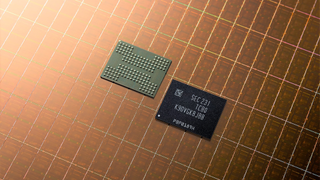Samsung 8th Gen V-NAND Pushes PCIe 5.0 SSDs Past 12 GBps
But when are actual products set to arrive?

Samsung announced today that it had begun mass production of its presumably 236-layer three-dimensional NAND memory, which the company brands as its 8th Generation V-NAND. The new ICs feature a 2400 MTps transfer speed, and when combined with an advanced controller, they can enable client-grade SSDs with a transfer speed of over 12 GBps.
The new 8th Generation V-NAND device features a 1Tb capacity (128GB), which Samsung calls the industry’s highest bit density without disclosing the size of the IC or the actual density. The IC also features a 2400 MTps data transfer rate, which is vital for the best SSDs featuring a PCIe 5.0 x4 interface that will offer blazing 12.4 GBps (or more!) once paired with an appropriate controller.
Samsung claims that the new generation of its 3D NAND memory will offer a higher per-wafer productivity compared to its existing flash ICs of the same capacity, something that lowers the company’s costs (provided the same yields), which potentially means cheaper SSDs.
Samsung’s new 1Tb 3D TLC 8th Generation V-NAND uses a quad-plane architecture to maximize parallelism and therefore improve performance.
“As market demand for denser, greater-capacity storage pushes for higher V-NAND layer counts, Samsung has adopted its advanced 3D scaling technology to reduce surface area and height, while avoiding the cell-to-cell interference that normally occurs with scaling down,” said SungHoi Hur, Executive Vice President of Flash Product & Technology at Samsung Electronics. “Our eighth-generation V-NAND will help meet rapidly growing market demand and better position us to deliver more differentiated products and solutions, which will be at the very foundation of future storage innovations.”
Samsung has not announced any actual products based on its 8th gen V-NAND memory, yet we can presume that the first devices will cater to client applications.
Stay on the Cutting Edge
Join the experts who read Tom's Hardware for the inside track on enthusiast PC tech news — and have for over 25 years. We'll send breaking news and in-depth reviews of CPUs, GPUs, AI, maker hardware and more straight to your inbox.

Anton Shilov is a Freelance News Writer at Tom’s Hardware US. Over the past couple of decades, he has covered everything from CPUs and GPUs to supercomputers and from modern process technologies and latest fab tools to high-tech industry trends.
-
dehjomz Any bets on what the next Samsung pcie 5.0 ssd will be called? The predecessor drives are the 960, 970, 980, 990… so is the next one in line the Samsung 1000 Pro? 12.5 GBps max ?Reply -
DavidLejdar It would sure be nice to know when they will arrive. Not in a rush myself though. I mean, despite still using GTX 1050 Ti in my new rig, in particular games load and run way nicer now, even though having "only" 3,500MB/s sequential read NVMe SSD so far. But at this point I doubt I would see a huge improvement about gaming if with a PCIe 5.0 SSD. And that partially because not many a game code seems to necessarily account for very fast storage access yet, and also because at currently 1080p here, there isn't as much data volume to load in during the game as e.g. at 4K with high-resolution textures. Still looking forward to PCIe 5.0 SSDs though, such as in regard to open-world games and non-blurred view distance.Reply
PlaneInTheSky said:who cares, it's random IOPS that count
Higher random IOPs sure is better. The number varies based on what queue depth the talk is about though. And how relevant it is, that also depends. I.e. about gaming, when a game has all the level data in a single file container, then the sequential read is way more relevant when "fast loading" is the primary goal for an user. -
Rdslw Reply
I guess you can go back to SATA then. We use BOTH, but almost every day is focused on IOPS, but ideally you want a mix, so a lot of small and a lot of medium size transfers can finish almost instantly. We can say 4K, and 4M size transfer rates is what we should care about.PlaneInTheSky said:who cares, it's random IOPS that count
For us, it means there will be new controllers designed, which should have both IOPS and top speed bumps.
I am personally happy that prices might drop.
Micron announced 232 like 3 months ago, and their previous offering was available ~6M after announcement, with another 3M before it was available without big orders.
I assume we might see first products with it around summer ? -
bit_user The article says "2400 MTps", but how big is a transaction? Specifically, I want to know whether these will only speed up larger transfers, or will they do anything to improve 4k IOPS?Reply
Not that I really care that much, but it'd be nice to know whether we might have already hit peak 4k IOPS and maybe now all we can get is faster big & sequential reads.
Most Popular



